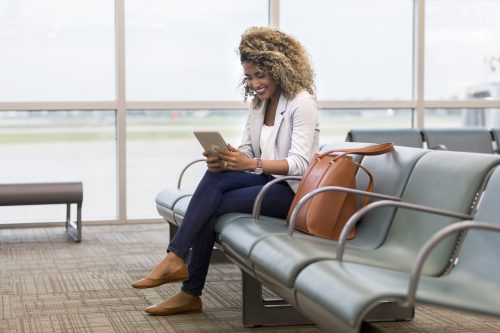So you’re packing for your next far-flung adventure and you’re thinking: Sunglasses? Check. Passport? Check. Eight pairs of black leggings? Check. Compressions socks? …Wait, why am I bringing those again? We heard you’re confused, so we asked a podiatrist about the need for special socks when you’re 35,000 feet in the air. What do compression socks do anyway?
“Compression socks are, as they sound, providing compression,” says New York City-based podiatrist Ernest L. Isaacson, DPM. “Blood is pumped away from the heart via the arteries, and then it comes back via the veins. That should be a pretty even process, but if the veins (or the lymphatic system), which drain the fluid out of the legs don’t work quite as well, you’re going to develop some kind of pooling in the legs.” In the high pressure environment of an airplane, the blood stops moving and your feet might swell up like twin balloons.
“That cabin pressure creates a situation where your veins don’t work as efficiently. The other thing that happens is that usually you’re in a cramped in corner, and you’re sitting in a position where your legs are down and also sitting a little bit behind you,” explains Dr. Isaacson. Like a hug from a good friend though, compression socks get the blood flowing back toward your ticker.
Dr. Isaacson explains that compression socks have long been recommended only to those at risk of developing blood clots. People with common risk factors for clots, like people who smoke, take birth control, have diabetes, are over the age of 40, or are pregnant may really notice the effects of the swelling. However, compression socks are now used more widely by passengers across all age groups and levels of well-being. “Now, they’ve sort of branched out from being something that was used as a treatment to something that’s preventative or just therapeutic—just to provide a little bit of extra compression and rejuvenate the legs,” Dr. Isaacson says.
Do you necessarily need to wear them if you’re not at risk for a blood clot? Well, no. If you’re not predisposed to blood clots, the risks of skipping the stockings—especially on short flights—is minimal. Same goes with life down here on earth. Research on the benefits of wearing compression socks while running has produced largely inconclusive results. And, again, Dr. Isaacson stresses that sitting at a 90-degree angle at your desk won’t be a problem for anyone without pre-existing threats to their heart.
Nevertheless, when you’re trapped in an ultra-cramped tube with wings for hours on end, it can’t hurt to sport a pair. (Hey, they’re cute!) Just make sure you show off your mile-high #fashion choice by taking plenty of walks down the aisle. The Center for Disease Controls and Prevention (CDC) says cabin calisthenics are a smart idea for any length of flight.
“If you’ve been sitting for a long time, take a break to stretch your legs,” instructs the CDC’s website. “Extend your legs straight out and flex your ankles (pulling your toes toward you). Some airlines suggest pulling each knee up toward the chest and holding it there with your hands on your lower leg for 15 seconds, and repeat up to 10 times.”
Thank you for flying with Well+Good. We hope you have a pleasant day wherever your final destination may be.
Now that you’re feet are taken care of, let’s talk about other self-care activities that cater to your in-flight enjoyment: face-masking and stretches you can do in your seat.
Sign Up for Our Daily Newsletter
Get all the latest in wellness, trends, food, fitness, beauty, and more delivered right to your inbox.
Got it, you've been added to our email list.









